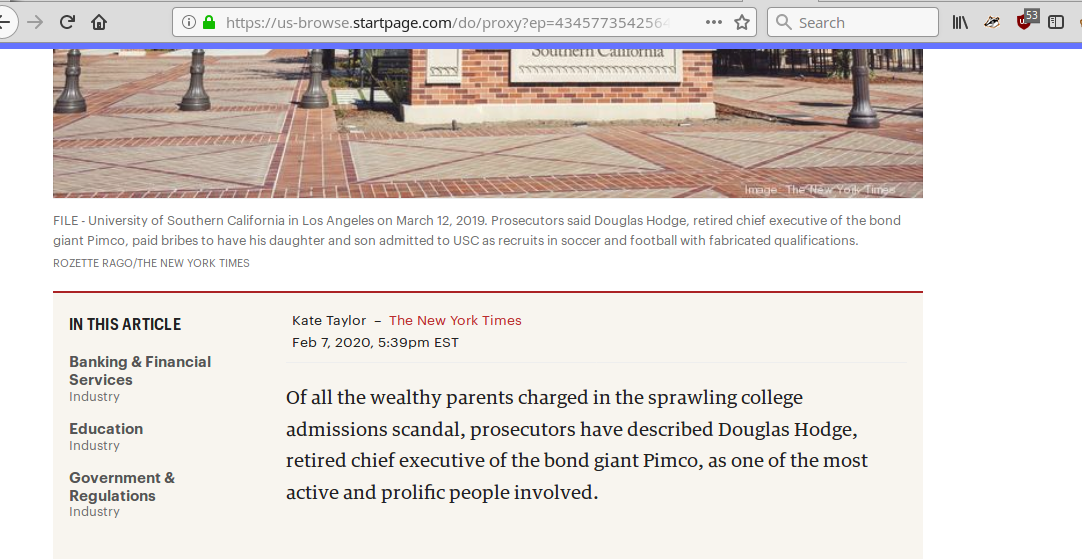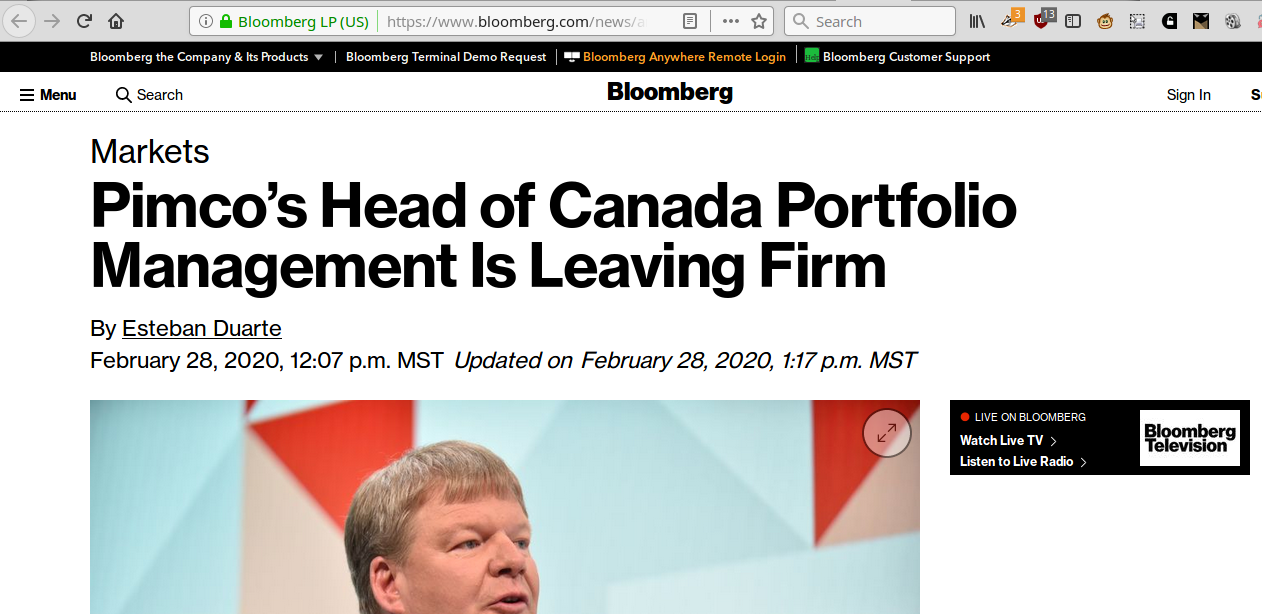
Moderators: Elvis, DrVolin, Jeff
Elvis » Sat Mar 21, 2020 1:09 pm wrote:^^^ That private equity stuff is gonna kill us all, thanks for those meaty pieces.
So I guess they're backing Biden as a hedge against a Trump loss...or do they actually prefer Biden?
JackRiddler » Fri Mar 06, 2020 10:22 pm wrote:.
(Who here has seen Gattaca? I'd guess everyone at RI, maybe not?)
This has enormous disaster capitalism potentials. Did you guys see how it went down in France? The PM claimed he could pass the long-protested pension package into law all by himself, by decree. So he decreed it. On the same day, he banned public gatherings due to Covid-19. The next day the workers started upping the ante, demanding closure of the Louvre on the same basis. With their contagion containment order the government has authorized the backfire of a general strike! I have no idea whether the "decree" in the meantime has been found to apply. But why not? As Mr. Jeff Wells said on Facebook, the ruling class has gone YOLO!
Once the precedents are established they cannot be forgotten. The liability fears alone will suffice to drive future panics about any developing outbreak. The insurance companies will start demanding all kinds of new coverage. It may become an annual thing, to go through the precaution program any time something novel might break out. They'd say it would be irresponsible not to, potentially thousands of deaths, etc. Infrastructure will be built. They will try to present it as a great case of international cooperation. In effect, this will contribute to what we might call the globalization of national lockdowns and aggressive, increasingly identical regimes in border, customs, travel surveillance, enforcement, etc.
I'm not in anyway arguing against responding to minimize spread and casualties from outbreaks of novel diseases, of course. The smartest measures in terms of lasting prevention would look like needed components in a strong program of ecological enlightenment and sustainability. (Examples: stop hunting and consuming the remaining wildlife to extinction. Clean drinking water for all.) I'm just telling you how the response never going to be separated from disaster capitalist exploitations of the crisis and statist-authoritarian growth. Not as long as the present global economic and political orders dominate.
For all cash-rich players on the market, the current crash or correction means now is the time to start up the next generation of bubbles. They'll be looking at related biotech and I expect especially at highly granular data/tracking applications, supposed prevention equipment, measures to secure enclaves from contagion, crowd control... plenty more I'm not thinking of directly.
Insurance is going to go nuts on this and basically act as a parallel body to the state for regulation, development and planing, as we've seen with many sectors.
538 or Ladbroke's should run a dystopia odds tracker, i.e., for people to bet on which of all our favorite dystopias will actually come true. The odds on Gattaca just shot up!
In Washington state (50,000 students) they canceled in-person classes through at least spring break, and replaced them with online classes. However that's going to work, on the fly. This may be a wet dream for a lot of higher education "reformers" who want to move in that direction anyway. Completing the casualization of adjunctification process. Laying off superfluous campus workers without impacting the all-important top 3% of administrators who get 20% of the salary pie. Hiring more of those, since this situation calls for a lot more control than we've had. Again, departments for insurance/liability compliance will mushroom.
.
Via: FT
The early stages of the coronavirus shock to markets followed a familiar script: stocks fell hard while the government bonds that investors crave in times of stress shot higher. It was painful for many fund managers but a standard response to the risk of a looming global recession.
But that pattern has begun to break down, with big slides in safe assets at the same time as historic drops in equities. This week that intensified, creating a “sell everything” mindset that stunned industry veterans.
“[It] was mind-boggling,” said Bob Michele, chief investment officer at JPMorgan Asset Management. “I have been doing this now for almost 40 years, and this is the strangest market I have ever seen.” The lack of a reliable asset that rallies in bouts of nerves is unprecedented, he said.
Prices of government bonds, usually financial markets’ ultimate safe harbour and a key reference point for assets across the world, flailed wildly over the past five trading days. They frequently tumbled in tandem with stock markets as investors yanked money out of funds at a record pace and portfolio managers scrambled to sell whatever assets they could.
In the early stages of the pandemic, investors piled into government bonds, pushing the US 10-year Treasury yield to a record low of less than 0.4 per cent on March 9. The reaction was similar across the Atlantic: 10-year yields in Germany, Europe’s ultimate haven, collapsed to an unprecedented minus 1 per cent.
...
Central banks have been compelled to provide backstops for fixed-income markets, which have arrived at dizzying speed. After the Federal Reserve’s announcement of at least $700bn of asset purchases last Sunday failed to calm markets, the European Central Bank followed with €750bn on Wednesday and the Bank of England with £200bn on Thursday.
The recent losses for government bonds have called into question their traditional role in investors’ portfolios, where they typically serve as a counterweight that rallies as riskier assets fall.
“The value as a hedge is just not there,” said Rick Rieder, BlackRock’s chief investment officer of global fixed income. He said he had sold US government bonds over the past two weeks even as stock markets were melting down, judging that there was little potential upside in owning them — but plenty of room for declines.
With the Fed cutting rates to near-zero and relaunching bond purchases, 10-year Treasury yields look attractive based on valuations, but the volatility is off-putting, Mr Rieder said on Thursday. “Now it makes sense to just own risk assets in smaller sizes and nothing else. The best hedge in our portfolio is cash.”
The world’s largest asset manager is not alone in this dash for liquidity. Investors pulled a record $109bn out of bond funds in the week to Wednesday, according to data from EPFR Global. Money market funds, which invest in cash-like short-term debt, have had record inflows. Treasury bills, which mature in one year or less and are seen as more akin to cash, have been in such high demand that yields turned negative this week.
Via: WSJ
Mortgage bond markets have also shown severe strains in recent days, and the New York Fed said Thursday it would purchase $20 billion in those assets later in the day and $32 billion more on Friday.
The Fed purchased more than $3 trillion in Treasury and mortgage securities in three separate rounds of bond buying, dubbed quantitative easing or QE, between 2008 and 2014.
To get a sense of the scale of recent purchases, the current round is on pace to exceed in just weeks the $600 billion in the second round of bond buying, called QE2, that the Fed conducted between November 2010 and June 2011.
Those programs were deeply controversial, drawing attacks from Republican lawmakers, conservative economists and some Fed officials. They warned it would lead to runaway inflation, which it didn’t, or that it represented an improper incursion by the central bank into fiscal policy.
Thus far, the purchases have met with few, if any, objections from lawmakers on Capitol Hill.
...
The current purchases are focused squarely on reducing turmoil in financial markets, rather than on stimulating economic activity.
“There’s no monthly cap here. There’s no weekly cap,” Fed Chairman Jerome Powell said Sunday. The central bank will buy assets “at a strong rate that we think will restore market function, restore liquidity as quickly as it can be restored,” he said.
Rising interest rates, now, when inflation is likely to decline means monetary policy is growing tighter at a time when the central bank is trying to ease financial conditions. Long-term bond yields have risen in recent days. Yields on 10-year Treasury notes have risen to more than 1.2% Wednesday from 0.6% on March 9.
“Higher real rates are a huge problem for the Fed and the global economy if they continue. In economic terms, they raise the cost of the recovery,” said Jim Vogel, an interest-rate strategist at FHN Financial.
Wombaticus Rex wrote:Some good background on the extent of the volatility right now:
Via: FT
Federal Reserve unleashes unlimited Treasury purchase plan
Historic pledge to buy corporate debt and securities backed by consumer loans but markets still slide
Global stocks fell on Monday despite the US Federal Reserve unleashing its full firepower to support the economy through the coronavirus outbreak when it pledged to buy government bonds in unlimited amounts.
The new measures, which include a historic step to buy corporate debt, add monetary heft to the effort to save the US economy, which is expected to contract sharply in coming weeks.
The Fed’s action came as senior Trump administration officials and congressional leaders clashed over a $2tn package of fiscal stimulus. There were more disagreements on Monday after friction between Democrats and Republicans had held up a deal over the weekend.
“The Federal Reserve is committed to using its full range of tools to support households, businesses, and the US economy overall in this challenging time,” the Fed said in a statement.
“While great uncertainty remains, it has become clear that our economy will face severe disruptions. Aggressive efforts must be taken across the public and private sectors to limit the losses to jobs and incomes and to promote a swift recovery once the disruptions abate,” it said.
In an unprecedented move for the central bank, the Fed unveiled two new facilities that allow it to purchase corporate bonds, including new issues. The Fed stopped short of buying corporate debt during the 2008 financial crisis.
...
The first facility to prop up large employers involves bridge financing for up to four years for investment-grade companies, in exchange for purchases of newly issued corporate debt by the Fed. Businesses could defer principal and interest payment to preserve cash for up to six months, but they would not be allowed to buy back shares or pay dividends if they tap the facility.
A second programme would allow the Fed to purchase corporate debt in the secondary market.
The Fed also on Monday revived TALF — a facility dating back to the 2008 financial crisis — which gives the Fed the ability to buy securities backed by student, car and credit-card loans, as well as loans to businesses through the Small Business Administration.
The US central bank said TALF and the other new programmes combined would provide up to $300bn in financing for “employers, consumers, and businesses”, backed by the US Treasury department, which is offering $30bn in equity from its Exchange Stabilisation Fund to support the measures.
Separately, the Fed also expanded existing programmes to ease strains in the markets for municipal debt and the short-term loans known as “commercial paper” and said it would soon announce a “Main Street Business Lending Programme” to lend directly to small businesses.
...
Following a meeting of the Federal Open Market Committee, its monetary policy setting committee, the US central bank is no longer putting a numerical cap on its purchases of Treasuries and mortgage-backed securities, instead signalling that it is prepared to buy as much as necessary.
“This is the first time they’ve really basically turned into a commercial bank instead of a central bank,” said Michael Feroli, chief U.S. economist at JPMorgan.
...
The central bank punctuated its moves, announced 90 minutes before markets in the U.S. opened Monday, with an unusually explicit warning about the perils ahead.
”It has become clear that our economy will face severe disruptions,” the Fed said in its statement Monday morning. “Aggressive efforts must be taken across the public and private sectors to limit the losses to jobs and incomes and to promote a swift recovery once the disruptions abate.”
...
The Fed’s latest lending facilities essentially bypass the banking sector and Wall Street dealers, which the Fed has flooded with cheap loans—so far to little effect. “The dealers and banks are supposed to intermediate markets, and they’re just not able to do it,” said Ms. Wilding of Pimco.
The big question now is how quickly the Fed, working with the Treasury Department and awaiting a potential infusion of funds from Congress, can limit a deepening working-capital crunch moving across the economy.
Once the facilities are launched, officials are likely to face tricky questions about how much farther to intervene in credit markets that remain in rotten shape, especially those for longer-dated municipal debt and riskier corporate credit.
While the Fed can’t directly purchase private-sector assets or longer-dated municipal debt, it has sweeping authorities that it has now invoked six times in the past week to lend on a broad basis during emergencies. These so-called 13(3) authorities are named for the section of its charter that authorizes this activity.
Still, there are limits to how far the Fed can go. The loans must be well secured, and the Fed often seeks a backstop from the U.S. Treasury when its lending could lead to significant credit losses, which it received for three lending facilities announced Monday and two others unveiled last week.
Economists now expect the economy to experience a severe downturn. Morgan Stanley expects the economy to contract at a 30% annualized rate in the April-to-June quarter, after a 2.4% contraction in the current quarter, which it said would send the unemployment rate to 12.8% this spring—the highest on records that date to 1948.
...
The Fed said it would soon roll out a Main Street Business Lending Program that will support lending to eligible small and midsize businesses. Such a program is likely to depend on additional money from the Treasury Department, and the Fed didn’t provide details about it Monday.
Amid negotiations over how lawmakers should respond to the coronavirus pandemic, Rahm Emanuel has reprised his famous rallying cry from his 2008 financial crash: Never let a crisis go to waste.
Speaking during an interview on ABC’s “This Week” on Sunday, the former Chicago mayor and chief of staff to President Barack Obama brought back his infamous quote from the 2008 financial collapse in an attempt to highlight that the government can learn from its mistakes when dealing crises.
“Never allow a crisis to go to waste,” Emanuel said Sunday. “Start planning for the future. This has to be the last pandemic that creates an economic depression. We're going to have more pandemics, but this has to be the last economic depression.”




Grizzly wrote:A debt jubilee is the only way to avoid a depression
Michael Hudson
https://www.washingtonpost.com/opinions ... epression/
Elvis » Tue Mar 24, 2020 5:02 pm wrote:Grizzly wrote:A debt jubilee is the only way to avoid a depression
Michael Hudson
https://www.washingtonpost.com/opinions ... epression/
Michael Hudson in the WaPo...cool.
U.S. Economy Grinds To Halt As Nation Realizes Money Just A Symbolic, Mutually Shared Illusion
WASHINGTON—The U.S. economy ceased to function this week after unexpected existential remarks by Federal Reserve chairman Ben Bernanke
https://www.theonion.com/u-s-economy-gr ... 1819571322
JackRiddler » Thu Mar 26, 2020 9:24 am wrote:identity, you're in New York? (Sorry if I've forgotten, and feel free to answer vaguely if that's your preference. There are a couple of other cities with $20K rents for simple storefronts.)
Users browsing this forum: Grizzly and 10 guests